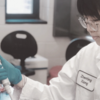Scope of Research
Oral diseases, while largely preventable, pose a major health burden and affect people throughout their lifetime. The Laboratory for Oral Health Translational Research is committed to preventing oral infectious diseases by focusing on translational studies that bridge basic science and clinical research. We believe that diagnostic and therapeutic discoveries require multidisciplinary integration of fundamental and patient-oriented research. Our mission is to improve early diagnostics and advance novel prevention and treatments. Ongoing research projects include:
Identifying Disease Mechanisms
Our clinical observational investigation is the starting point for our research. Through microbiological screening, we identified Candida albicans (a fungus) in plaque biofilm from children with severe tooth decay, opening up new questions regarding the microbial etiology of the disease. We have discovered that C. albicans can synergistically interact with the cariogenic pathogen S. mutans. Once together in biofilms, these organisms can cooperate by providing substrates/metabolites, growth-stimulating factors, and EPS production, promoting biofilm accumulation with increased acidogenecity. In order to determine whether there is a causal link between fungal infection and tooth decay, we initiate a longitudinal clinical study and employ in vitro multi-species biofilm models combining cutting edge imaging/engineering technologies to elucidate the underlying mechanisms. Additional microorganisms that are tightly linked to disease outcome will be selected for further study. Our research has a translational focus, attempting to link basic microbiology to clinically relevant pathology.
Characterize Biofilm-OMICS
Biofilms are communities of microorganisms (e.g., bacteria, fungi, viruses), which serve an essential role in health and disease. Despite extensive work to identify biofilm bacterial components, much remains unclear regarding the mechanisms driving the organization, stability and interactions of the biofilm community as a whole. To fill these gaps in our knowledge, we will integrate omics approaches and combine state-of-the-art imaging technologies to understand interspecies and interkingdom interactions as well as the role of spatial structure, including biofilm matrix, in community function. We will also combine live imaging with in situ microbial metabolic measurements to simultaneously follow biofilm development and interactions promoting growth and fitness as a function of time. Understanding the role of community interactions in the maintenance of health and in driving transition to dysbiosis and disease in the oral cavity is clinically relevant and could lead to new effective therapeutic strategies.
Develop New Therapeutic and Prevention Approaches
With developments in material science and nanotechnology, we have developed a potent and biocompatible anti-biofilm/anti-caries approach using FDA-approved nanoparticles that activate hydrogen peroxide in situ that dismantle and kill biofilms in pathological acidic conditions. Our therapeutic approach can precisely target the diseased sites to prevent caries onset without disrupting the ecological balance of the oral microbiota or causing harm to the host tissues. We continue exploring novel approaches targeting by targeting virulence factors and pathogenic microenvironments and modulating ecological dysbiosis. In the future, we envision bringing new treatments to clinical application.
Facilities
Located on the third floor of the Kornberg School of Dentistry, the Laboratory of Oral Health Translational Research contains the major equipment including the following:
- CO2 incubator
- Multiplex real-time polymerase chain reaction (PCR)
- Nano-volume spectrophotometer
- PowerLyzer homogenizer
- Fluorescent stereoscope
- Light microscope and stereoscope
- Refrigerated microcentrifuge
- Benchtop centrifuge
- Vacuum centrifuge/concentrator
- Microbalance
- Heating and drying oven
The laboratory is designated as a biosafety BSL-2 facility by Temple University’s Biosafety Committee.



